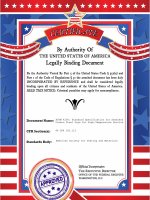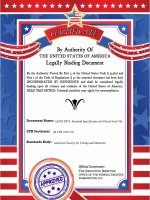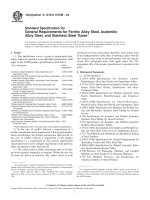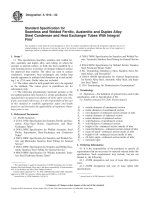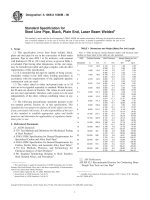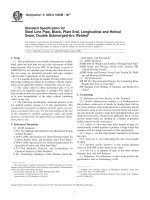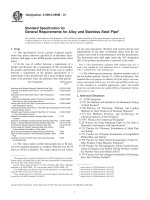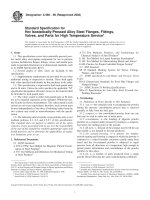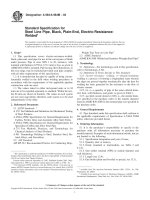ASTM D1-15 Specification for Raw Linseed Oil
Bạn đang xem bản rút gọn của tài liệu. Xem và tải ngay bản đầy đủ của tài liệu tại đây (279.66 KB, 3 trang )
AMERICAN SOCIETY FOR TESTING MATERIALS
PHILADELPHIA, PA., U. S. A.
AFFILIATED WITH THE
INTERNATIO NAL ASSOCIATION FOR TESTING MATERL<\LS .
STANDARD SPECIFICATIONS
FOR
PURITY OF RAW LINSEED OIL FROM NORTH
AMERICAN SEED.
Serial Designation: D 1-15.
The specifications for this material are issued under the fixed designa-
tion D 1; the final number indicates the year of original issue, or in the case
of revision, the year of last revision.
ADOPTED, 1913 ; REVISED, 1915.
I. PROPERTIES AND TESTS.
1. Raw linseed oil from North American seed shall conform Properties.
to the following requirements:
15°.5 MAxlMUill . MINIMUM,
Specific Gravity at - -0 C... .. .. . . .. .. .. . .
15 .5 0.936 0.932
or 250
Specific Gravity at 250C· ..... ... .. .. ··· ·· 0.931 0.927
Acid Number ........ . ...... . . .. .......... . 6.00 189
Saponification Number ....... . ............ . 195
Unsaponifiable matter, per cent ............. . 1.4790
1. 50 180
Refractive Index a 25 ° C........... . . . .. , .. 1. 4805
Iodine Number (Hanus) . . ........... .. ... . .
II. METHODS OF TESTING.
2. The recommended methods of testing are as follows: Methods of
Generat.-A!l tests are to be made on oil which has been Testing.
filtered at a temperature of between 60 and 80° F. through
(497)
498 SPECIFICATIONS FOR l?uRITY OF RAW LINSEED Ort.
paper in the laboratory immediately before weighing out. The
sample should be thoroughly agitated before the removal of a
portion for filtration or analysis.
Specific Gravity.- Use a pyknometer, accurately standardized
and having a capacity of at least 25 cc., or any other equally
accurate method, making a test at 15°.5 C., water being 1 at
15°.5 C., or a test at 25° C., water being 1 at 25° C.
Acid Number.- Expressed in milligrams of KOH per gram of
oil. Follow the method described in Bulletin No. 107, revised
1908, Department of Agriculture, Bureau of Chemistry, page 142.
Saponification Number.- Expressed as with Acid Number.
Blanks should also be run to cover effect of alkali in glass.
Follow method given in Bulletin No. 107, revised 1908, Depart-
ment of Agriculture, Bureau of Chemistry, pages 137- 138.
Unsaponifiable Matter.- Follow Boemer's method taken
from his Ubbelohde Handbuch Der Ole u. Fette, pages 261-262 .
"To 100 g. of oil in a 1000 to 1500-cc. Erlenmeyer flask add 60 cc.
of an aqueous solution of potassium hydroxide (200 g. KOH
dissolved in water and made up to 300 cc.) and 140 cc. of 95-per
cent alcohol. Connect with a reflux condenser and heat on the
water bath, shaking at first until the liquid becomes clear. Then
heat for one hour with occasional shaking. Transfer while yet
warm to a 2000-cc. separatory funnel to which some water has
been added, wash out the Erlenmeyer with water using in all
600 cc. Cool, add 800 cc. of ether and shake vigorously one
minute. In a few minutes the ether solution separates perfectly
clear. Draw off the soap and filter the ether (to remove last
traces of soap) into a large Erlenmeyer and distill off the ether,
adding if necessary one or two pieces of pumice stone. Shake
the soap solution three times with 400 cc. of ether, which add to
the first ether extract. To the residue left after distilling the
ether add 3 cc. of the above KOH solution, and 7 cc. of the
95-per cent alcohol, and heat under reflux condenser for 10
minutes on the water bath. Transfer to a small separatory fun-
nel, using 20 to 30 cc. of water, and after cooling shake out with
two portions of 100 cc. of ether; wash the ether three times with
10 cc. of water. After drawing off the last of the water, filter
the ethereal solution so as to remove the last drops of water,
distill off the ether, dry residue in water oven and weigh."
SERIAL DESIGNATION : D I - 15 . 499
Or, any accurate method involving the extraction of the
dried soap may be used.
Refractive Index.-Use a properly standardized Abbe
Refractometer at 25° C., or any other equally accurate in-
strument.
Iodine Number (Hanus).-Follow the Hanus method as
described in Bulletin No. 107, revised 1908, Department of
Agriculture, Bureau of Chemistry, page 136.
